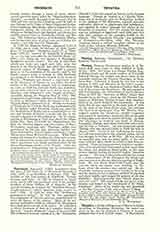

Thurmayr, JOHANNES (called AVENTINUS from the place of his birth), b. at Abensberg, Bavaria, July 4, 1477; d. at Ratisbon, January 9, 1534. He studied at the Universities of Ingolstadt, Vienna, Cracow, and Paris. In 1507 he returned to Ingolstadt, and in 1509 was appointed tutor to the younger brothers of Duke William IV of Bavaria. In his zeal for learning he founded the “Sodalitas litteraria Angilostadensis”, which, however, soon ceased to exist (1520). In 1512 he wrote the “Rudimenta grammaticae latini”. In 1517 he was appointed historiographer of Bavaria and was commissioned to write the history of the country, Many of the important authorities which he collected for this purpose have been preserved only in his copies. He embodied a critical treatment of them in a complete history of Bavaria, “Annales Bojorum”, down to the year 1460. His condensed German version of it, the “Bayerische Chronik”, is the first important history in the German language. Though he ranked as a Catholic, Thurmayr was in sympathy with the Humanists, inclined to the opinions of the Reformers, rejected auricular confession, objected to pilgrimages and indulgences, and opposed in violent language the claims of the hierarchy as excessive. For this reason his history was not published at Ingolstadt until 1554, and then only with omission of the passages hostile to the Church. The “Bayerische Chronik” was published at Frankfort-on-the-Main, 1566. The Bavarian Academy issued a critical complete edition of his works in five volumes (Munich, 1880-86).
PATRICIUS SCHLAGER

